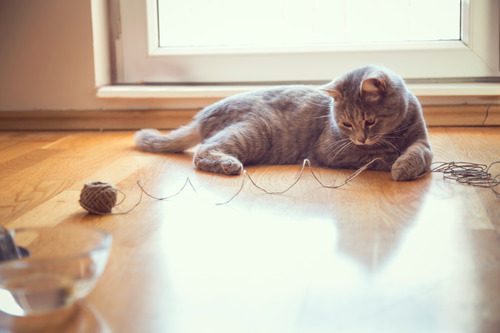My Cat Swallowed a String, What Do I Do?
Cats are known for their curious nature and love of play, especially when it comes to string-like objects. Whether it’s a piece of yarn, ribbon, dental floss, or even a shoelace, these enticing objects can quickly become dangerous if swallowed. If you’ve just realized your cat swallowed a string, you’re likely feeling a mix of panic and confusion. In this blog, we’ll explore what may happen when a cat swallows a string, why it’s an emergency, and how your veterinarian can help. Read on to better understand what’s at stake and what steps to take next if your cat is facing this situation.

Why a Swallowed String is a Medical Emergency
When a cat swallows a string, the danger often lies beyond what you can see. Unlike small, solid objects that may pass through the digestive system without incident, string and similar materials are classified as “linear foreign bodies.” These can get caught in different areas of your cat’s digestive tract, creating significant complications.
Linear foreign bodies tend to anchor in one location (commonly under the tongue or at the base of the stomach) while the rest of the string continues to move through the intestines. As the intestines contract to move food along, they can begin to bunch up around the string, potentially leading to intestinal blockage, lacerations, or perforation. This kind of internal trauma can become life-threatening without prompt veterinary attention.
Symptoms to Watch for if Your Cat Swallowed a String
If you suspect your cat swallowed a string, monitoring their behavior and physical symptoms is key. You may not always see the ingestion happen, but the following signs can indicate something is wrong:
Vomiting or Gagging
One of the most common early symptoms is vomiting. Cats may also gag or retch repeatedly. These signs can occur as the string irritates the gastrointestinal tract or causes a partial blockage.
Loss of Appetite
If your cat stops eating or seems disinterested in food, it may be due to nausea or discomfort caused by the foreign object.
Lethargy
A cat who’s typically active but suddenly becomes sluggish or withdrawn could be experiencing internal distress. Lethargy is a common sign of digestive upset and should never be ignored.
Abdominal Pain or Swelling
Your cat may guard their belly, vocalize when touched, or exhibit an unusual posture such as hunching over to avoid aggravating pain. In some cases, the abdomen may appear bloated.
Changes in Bowel Movements
Diarrhea or constipation can result from a partial or complete blockage. You may also notice that your cat strains to defecate but produces little to nothing. These symptoms can worsen rapidly. If you see any of them, or if you’ve witnessed your cat swallow a string, contact your veterinarian right away.
What You Should Not Do if Your Cat Swallowed a String
It’s natural to want to help your cat immediately, but some actions can make the situation worse. Here’s what not to do:
Don’t Pull the String
If part of the string is visible in your cat’s mouth or coming from their rear, do not attempt to pull it out. Tugging on it could cause the string to slice through the intestines or become further entangled.
Don’t Wait and See
In some situations, pet owners hope their cat will pass the string on their own. However, this can delay critical care. Because complications can escalate quickly, it’s best to have your cat evaluated as soon as possible, even if they seem normal.
Don’t Try Home Remedies
Avoid giving your cat food, oil, or laxatives in an attempt to “move things along.” These approaches are ineffective and can be dangerous in cases involving foreign objects.
How Your Veterinarian Diagnoses and Treats a Swallowed String
Once you bring your cat in, your veterinarian will begin with a physical exam and a review of your cat’s symptoms. If you mention that your cat swallowed a string, this will significantly help guide the next steps.
Diagnostic Imaging
To confirm the presence and location of the string, your veterinarian may perform X-rays or an abdominal ultrasound. These tools help determine whether the string is causing a blockage or has perforated the intestines.
Bloodwork
Blood tests can provide insight into your cat’s hydration, organ function, and whether there’s an infection present. These results help inform the urgency and nature of treatment.
Surgery or Endoscopy
Treatment often depends on where the string is located. If it’s caught in the stomach or intestines, surgical removal may be necessary. In less severe cases, your vet might use an endoscope, which is a flexible tool with a camera, to retrieve the object through the mouth. Prompt treatment offers the best chance for recovery and can help prevent long-term damage.
Why Cats Love String (and Why It’s So Dangerous)
Understanding why cats are attracted to string can help you prevent future incidents. Their natural hunting instincts drive them to chase, pounce, and bite at long, thin objects that mimic the movement of prey. Unfortunately, string-like items can be especially dangerous because they’re easy to swallow and hard to digest.
Common Offenders in the Home
Keep an eye out for these common items that cats often try to chew or swallow:
- Yarn and knitting supplies
- Dental floss
- Hair ties
- Rubber bands
- Ribbon from gifts or balloons
- Drawstrings from clothing or bags
- Thread from sewing kits
These items should be stored securely out of your cat’s reach. If your cat enjoys string toys, choose ones that are used only during supervised play sessions and stored away afterward.
How to Prevent String Ingestion Accidents
Prevention starts with understanding your cat’s behaviors and making small adjustments around your home. Cats who are frequently bored or left alone for long periods may seek out inappropriate items to chew.
- Provide Enrichment: Rotate your cat’s toys regularly to keep them interested. Puzzle feeders, wand toys, and interactive play sessions help satisfy their need to stalk and pounce in safe ways.
- Secure Hazardous Items: Keep potentially dangerous items in drawers, containers, or cabinets. When wrapping gifts, sewing, or flossing, be mindful of where discarded materials end up.
- Offer Safe Alternatives: If your cat loves the texture or movement of string, look for safer alternatives like fleece strips or crinkle toys that don’t unravel easily.
When It’s Time to Call Bottletree Animal Hospital
If your cat swallowed a string, you don’t have time to wait it out. Fast action can make all the difference. The team at Bottletree Animal Hospital in Oxford, Mississippi, is equipped to diagnose and treat foreign body ingestion cases with precision and care. Our veterinary professionals will work closely with you to determine the safest path forward for your cat. If your cat shows any unusual symptoms or you suspect they’ve eaten something they shouldn’t have, call us immediately at (662) 234-4336. We’re here to support you with clear communication, efficient care, and experience you can trust.
Recent Posts
About Us
Welcome to Bottletree Animal Hospital, your family-friendly veterinarian in Oxford. We are a team of animal lovers who are passionate about veterinary excellence. We love working closely with you and your pet to help us learn more about your furry friend, their lifestyle, and their needs.

